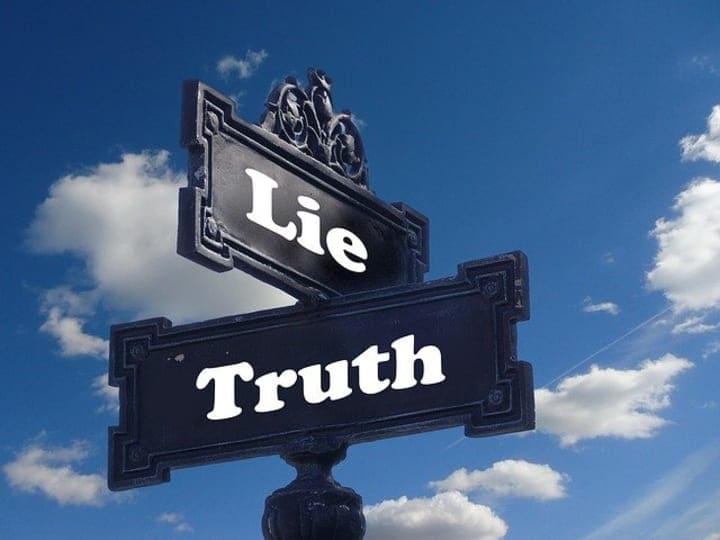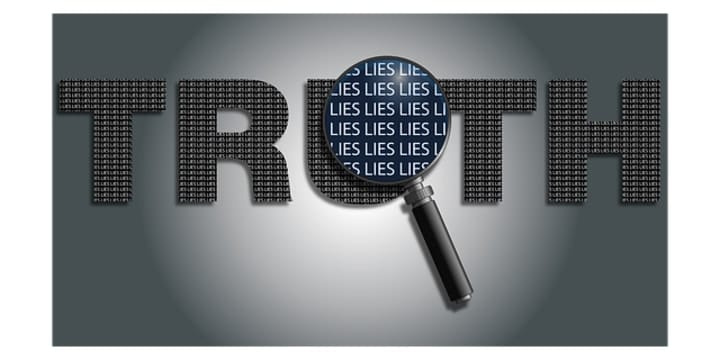SPY the Lie: Deception Detection Techniques
The methodology described in this book is very simple and a person can use it in one’s personal life as an armor against lies, deceptions or liars very easily.

Deception or lie is very common in our life and each of us experiences these regularly. Failing to handle those properly means monetary and other types of losses. But if we can follow certain techniques or methodologies, we can manage deception in much better ways. We are going to learn about those in the article below.
Chapter-01 & 02: The Difficulty We Have in Calling Someone a Liar

People do not believe lies because they have to, but because they want to. —Malcolm Muggeridge
The number one obstacle to declaring someone a liar is our general tendency to think positively about anyone before s/he is proven guilty. We do not want to consider in the first place that somebody can be a liar. We love innocence and also love to think others innocent as well. But this attitude is an impediment to detecting deception effectively and the reality is that people lie more than we think. In research, it is found that people lie at least ten times in twenty-four hours. Moreover, judging others without any reason is really uncomfortable for us. It also helps liars to get themselves covered and remain unsuspected by others. While detecting lies, we have to bear in mind that our main aim is not to judge somebody. Rather, It is to detect the deception based on evidence and fact.
Secondly, there are certain behavioral traits that we do not want to suspect at any time. We accept those granted as guilt-free long before it becomes evident. The third point is that we have difficulty in understanding the verbal and non-verbal communication of a liar. It is evident in the research that most of the communications are in non-verbal expressions which we hardly notice or are aware of. Fourthly, our biases play a negative role in making good decisions. Naturally, we are biased. It is not part of the problem. Complexity occurs when we fail to recognize our biases properly, manage those and get beaten by those while deciding something very critical like detecting deceptive behaviors. Lastly, we cannot ignore the overabundance of information load while living in a digital age. The amount of information is too much to determine the right one for detecting a liar or for taking an objective decision.
Chapter-03: The Methodology of Deception Detection

Advances are made by answering questions. Discoveries are made by questioning answers. —Bernard Haisch
The beauty of this methodology lies in the simplicity of using it. It is based on one strategic principle and two guidelines. The strategic principle is that when someone is trying to detect a liar, one has to ignore truthful behavior very carefully.
Two underlying guidelines are timing and cluster. The question set is prepared very carefully so that sensory stimuli are addressed. After each question is asked, the stimuli create a trigger in the subject which will stay for five seconds only. After this short time period, the reaction fades away and the effect of another stimulus will start to affect. A cluster is a set of two or more deceptive indicators comprising both verbal and non-verbal communications together. For that, at the time, the interviewer needs to put sharp eyes on the person and have his ear open so that he can assess the non-verbal reaction along with the verbal ones. It has already been mentioned that most of the communications take place non-verbally. If the deceptive pattern occurs only once, there is no reason to affirm the deception for certain. Rather, more dig downs may be necessary for more clarity. It is true that the greater the deceptive patterns, the stronger the assumption.
Chapter-04: The Deception Paradox: Ignoring the Truth in Order to Find Out the Truth

No mask like open truth to cover lies, As to go naked is the best disguise. —William Congreve
A truthful person is alert, composed and attentive. If a liar or deceptive person pretends to be a truthful person, it becomes very difficult to recognize him/her at the first sight. That is why it is important to ignore truthful behavior at the beginning and find out more. One more thing needs to be kept in mind that disguised truthfulness can be used as a weapon to dodge or hide from being caught.
Chapter-05: What Deception Sounds Like

We are familiar with the courtroom drama on TV programs in which an oath is administered when someone is sworn to testify: “Do you solemnly swear to tell the truth, the whole truth, and nothing but the truth, so help you, God?” “To tell the truth” covers the lies of commission. These lies are straightforward lies that are exactly the opposite of the actual truth. “The whole truth” covers lies of omission. It is more like telling the half-truth, a mixture of truth and falsehood. This strategy is better than the lies of commission. “And nothing but the truth” covers lies of influence. This is very interesting and powerful It contains the whole truth which is enough to manage someone’s perceptions but in addition, the latter part is a blatant lie that hardly captures anybody’s attention.
Here are some examples of verbal behaviors that people show when they find that facts are not in their favor. Failure to answer a question appropriately takes place for multiple reasons. For example, someone may misunderstand the question, take time to get the answer ready etc. In that case, we have to carefully apply the cluster rule which requires us to consider both verbal and non-verbal communications. Denial Problems involve denying the whole thing straight. Denial is of two types; nonspecific denial and isolated delivery of denial. Non-specific denial relates to answering in a general sense rather than specifically telling ‘No”. Another red flag is Reluctance or Refusal to answer using marker-like, ‘I am not sure’, ‘I am not the right person to talk to’ or ‘I am not sure I can answer that’. The Question is repeated by a liar sometimes to fill the time of silence or revert the awkward moments which he does not want to confront.
The non-answer statement is almost similar to the previous one. Inconsistent Statement involves speaking but not in line with the answers accordingly to the questions. Going into attacking mode involves becoming aggressive instantly and the markers are ‘How long have you been doing this job?’, “Do you know anything about our organization’, ‘Why are you wasting my time with this stuff?’, ‘Why do you always pick on me?’, ‘Why don’t you trust me?’. Asking an inappropriate question is against a question rather than answering is a marker of potential deceptive behavior.
Chapter-06: The Most Powerful Lies

Let your lie be even more logical than the truth itself, So the weary travelers may find repose.--- Ceslaw Milosz
These are the most difficult types of lies to decode because they are very convincing, reasonable and simple. These are very difficult to detect because they make so much sense. As a specialist, you may think about the liar that if I were in that position, I would say the same thing. There are certain convincing statements to strengthen the lies. Examples are no one would ever question my honesty, I have a great reputation, I’m an honest person.
Three characteristics of strong lies are :
These are irrefutable and very convincing . The statements are full of emotions which are used to make the whole thing portrait so real . Most importantly, the statements are capable of managing the investigator’s biases.
Chapter-07: The wrath of the Liar
When a liar is almost detected, s/he starts to show the attack behavior. The attack can be in both forms; verbally and non-verbally. When a person starts to show attack behavior, it is an important clue to detecting a liar.

Chapter- 08: What Deception Looks Like
There are certain behaviors that are potentially deceptive in nature. For example, after a question is asked, a liar looks for a behavioral pause and tries to reply a bit later. The verbal and non-verbal disconnect is also a red trigger. For example, one is nodding affirmatively while saying “No, No”. When a person lies, it is his/her general tendency to hide their mouth or eyes in order to disguise their emotions. Throat-clearing or swallowing is another important clue. Checking out the hand-to-face activity is crucial when a liar is interviewed. These include biting or licking lips, pulling on the lips or ears etc. Anchor-point movements are important signs. A person's anchor points help him/her to anchor in a certain position. For example, while standing, a person’s anchor point is his/her feet. The next anchor point may be one’s arms. If a person sitting on a chair, his primary anchor point is his buttock, his back and his feet. Grooming Gestures are also important. These include adjusting one’s ties, shirts, hair, glasses when a person answers questions asked by an interviewer.
Chapter-09: Truth in the Lie: Spying Unintended Messages
“I apologize for lying to you. I promise I won’t deceive you except in matters of this sort”--- Spiro T. Agnew
Important unintended messages are inbuilt in lies which somebody can hardly surface if s/he is not literally expert. For detecting the deception effectively, it is important to consider every single point very carefully, including all literal smart points which may dodge a person’s eye easily if s/he is not educated about that or aware of that. To delve into unintended points, the interviewer asks a certain type of questions which are known as punishment questions;
For example, What do you think should happen to the person who did this?
This is an interesting perception. As an interviewer, if you ask a liar ‘what should be the exact punishment for this heinous deed?’, on most occasions, the liar will suggest less punishment than that the victim anticipates. One flaw is that if the liar can understand that it is the punishment question, s/he will certainly answer in a way that will manage the interview’s perception. In that case, we have to be careful so that we can ignore truthful behavior in order to find out the truth.
Chapter-10: You Don’t Ask, You Don’t Get

All truths are easy to understand once they are discovered; the point is to discover them.--- —Galileo Galilei
The questioning process is the most sensitive and important part of the deception detection methodology. The below discussion is about various questions patterns. “What else” are really powerful two words that really help to dig deeper. Sometimes, the interviewer may be confused about the answers. In those cases, s/he may ask for clarifications with these two words which are really helpful. The ability to follow up questions properly actually makes or breaks up an interview. The follow-up can be done by asking the below questions. Evaluation is done to test the information which an interviewee provides. The examples are, “Why do you say that?” , “How do you know that to be true?” , “On what do you base that information?” Exploration is necessary for getting some additional information. The example questions are “What else?” ,“Tell me more.” “I don’t understand.” Clarification helps to ensure the previous statements which a liar has already made. The examples are, “Which Sam are you referring to?” , “Tell me again what time you left.” , “Is it possible you were there longer?”
Types of questions:
Open-ended Questions: These provide the crucial basis for the discussion and help to explore an issue. For Example, tell me what did you do yesterday after arriving home? Close-ended questions help to dig specific matters deeper. Example; Did you visit Rahman’s house yesterday? Presumptive questions are the questions that are asked to ensure a presumption. Example: did you log in to any of the computers besides yours? When Bait Questions are asked, A hypothetical situation is established to trigger a mind virus. Example: If your coworkers are asked, is there any reason they would say that you log in to any of the computers besides yours? Opinion Questions are asked to seek the opinion of a liar about a particular issue. Example: What do you think about the new policy that the company has adopted recently? Catch-all-questions help to discover the lies of omissions. For example, what have not I asked you which I should know about?
The Questions below need to be avoided while interviewing a person
Negative questions: Communicating a biased or negative vibe to an interviewee before the real incident is discovered is the wrong way. These types of questions are an impediment to finding out the truth. An example of this type of question is “Do not you know somebody’s password who is sitting beside you? Compound questions: If the question which has been asked is too long and has multiple parts, it will be difficult to establish which part is causing the deceptive behaviors. As a result, the interview may fail. Example: “What time did you arrive yesterday, and how long were you there?” Vague Questions: These are questions that contain excessive latitudes. A person can take the discussion anywhere s/he wants which makes the whole thing more difficult to pinpoint. Example: “Can you give me some of your thoughts about what’s going on?”
Chapter-11: Managing Deception to Gain the Advantage
He who permits himself to tell a lie once, finds it much easier to do it a second and third time, till at length it becomes habitual —Thomas Jefferson
There are certain points followed to gain an advantage while interviewing someone. These are: Carefully avoiding negative questions ; using prologue for key questions. A prologue is a short narrative explanation that comes before a question; Staying cool as it can be frustrating to deal with deceptive behaviors; Overcoming psychological alibis is important. Statements like, “I don’t remember,” or “Not that I recall are not acceptable. These are deceptive signs. “Not to my knowledge” can well be the most appropriate truthful response; Broadening the focus of the interviewer is also important to get to the track.
Chapter-12 & 13: Let’s Be Careful Out There
Micro-expressions are extremely important and must be considered with a certain amount of care. Eye contract gives important clues regarding deceptive behaviors. Closed posture is sometimes associated with non-co-operation and shutting down something. The general nervous system can be taken care of as there is a close link between anxiety and deception. Preemptive Responses involve responding to a question before the interviewer finishes questioning it and it is a potential red flag. Besides, Blushing or twitching, clenched hands, baselining can also be important points that have to be taken into account.
Thanks a lot for your patient reading. If you like this story, please give me a heart. A tip s not necessary but is an encouragement for more creation.
I never encourage deceit, and falsehood, especially if you have got a bad memory, is the worst enemy a fellow can have. The fact is truth is your truest friend, no matter what the circumstances are. Abraham Lincoln
Susan Carnicero, Co-author of Spy the Lie, is talking about How to Spot a Lie in the video below, source: Digiday YouTube Channel,
Former CIA officer Phil Houston in the video below is talking about his book "Spy the Lie." source: CBS News YouTube Channel
Lance Armstrong's confession: How believable is it? Source: CBS News YouTube Channel
About the Creator
Moshiur Rahman
My mother tongue is not English. But I like to imagine, think and write in English just because it is my passion and I love to do that.






Comments
There are no comments for this story
Be the first to respond and start the conversation.